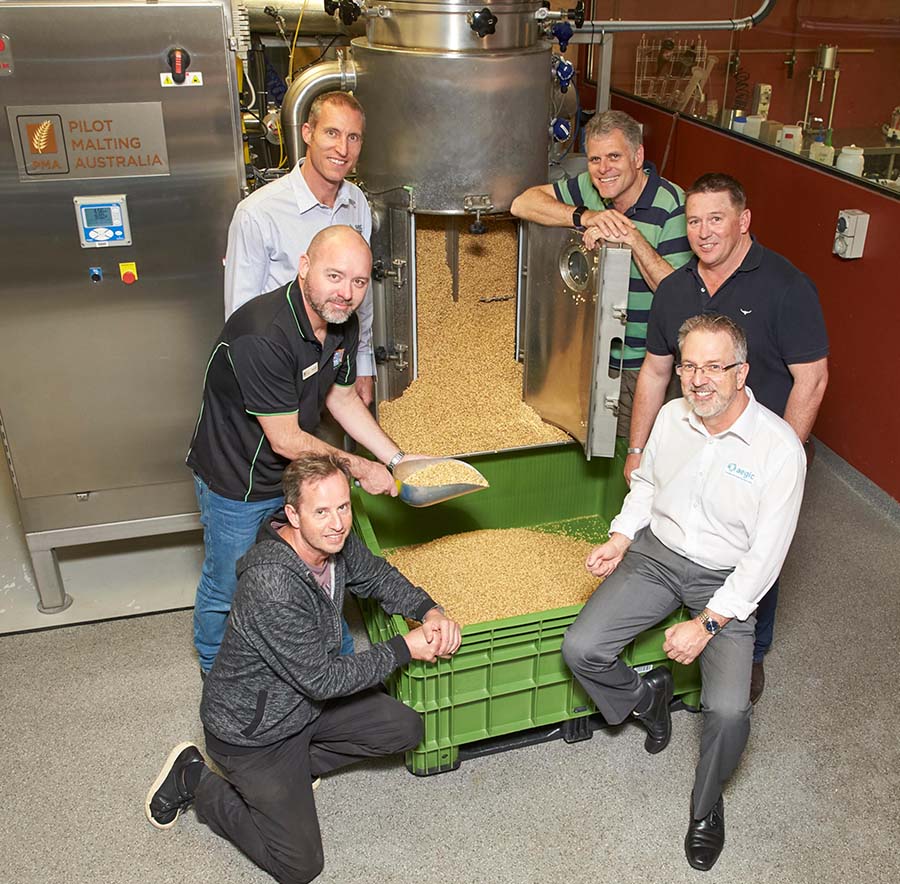Barley researchers and industry representatives from across the country gathered in Western Australia in September to consider the latest findings, innovations and future challenges for Australia's barley industry at the 2019 Australian Barley Technical Symposium (ABTS).
First held as a small meeting of industry participants at a brewery in 1981, the symposium has since grown to attract some of the industry's most acknowledged researchers, agronomists, geneticists, maltsters, brewers, marketers and growers, to discuss key issues affecting the entire barley production chain.
Australia is the world's fourth-largest barley producer, with production increasing dramatically across the country during the past five years. Only the European Union, Russia and Canada produce more barley than Australia.
Since 2013, Australia has produced more than eight million tonnes (mt) of barley annually. About 70 per cent is exported, most of which is sold to China.
Barley, plus malt made from Australian barley, is primarily exported for food, beer, whisky and animal feed end-use purposes.
Barley Australia executive chair Dr Megan Sheehy told the symposium that Australia supplies about one-third of the malt barley traded globally per year - 1.4 to 2.1mt of barley grain, along with about 0.7 to 0.9mt of processed malt. Domestically, 200,000t of malted barley is retained for Australian brewing purposes.
"A point of difference for the Australian barley industry is that there are two distinct markets to service - a domestic market and an export market, each of which has different requirements and needs for their respective malt and raw barley," Dr Sheehy said.
"This is due to a fundamentally different style and method of brewing whereby, in Australia, brewers use largely sugar as an adjunct, while in Asia, solid adjuncts - such as rice - are predominantly used in the brewing process."
A point of difference for the Australian barley industry is that there are two distinct markets to service - a domestic market and an export market, each of which has different requirements and needs.
Barley Australia executive chair Dr Megan Sheehy
Genetic gains

Barley industry representatives at the announcement of the stage-one accreditation of Pilot Malting Australia, discussed at the 2019 Australian Barley Technical Symposium held in Perth, Western Australia. Photo: DPIRD
The significant increase in total barley production across the country can be attributed to the increased yields derived from matching the agronomy of improved genetics in new varieties with the environment in which they are being grown, according to ABTS chair Blakely Paynter, who is a senior research officer with WA's Department of Primary Industries and Regional Development (DPIRD).
Australian economic analysis has demonstrated the gains from combining best-practice agronomy with the new genetic characteristics, which has allowed for barley profits to exceed wheat in many cereal production zones.
These rapid genetic gains, made by both pre-breeders and commercial breeding companies, have flooded the market with a wide array of choices for both growers and the export market to cope within such a short space of time.
Variety challenges
Mr Paynter said that after a reliance on only two or three varieties up until 2002, the flood of new varieties now available to growers was exciting - but required careful management.
"We have seen the introduction of varieties such as Baudin (PBR), La Trobe (PBR), Bass (PBR) and Spartacus CL (PBR), and more recently RGT Planet (PBR), which has made barley production a very profitable option across the grainbelt," he said.
"But with such an influx of new varieties, we need to ensure the marketing and brewer acceptance can keep up this same pace."
Since 2002, 24 new varieties have been introduced in WA alone, he said. While this is good news for growers, there was still confusion in the industry as to which varieties were preferred by global markets.
"The challenge for the industry is to balance the frequency of these varieties coming on to the market with improved genetic traits that deliver profitability to growers," Mr Paynter said.
On-farm challenges
The chair of the Grains Industry Association of Western Australia's (GIWA) Barley Council, Lyndon Mickel, said the multitude of new barley varieties now on offer also poses challenges with segregations in the storage system.
"Unlike wheat, barley is segregated by variety, not by quality, and - with so many new varieties now available to growers - this presents some challenges in terms of storage and handling," Mr Mickel said.
"Now that we have seen these impressive genetic gains, we must focus our breeding attention on only the qualities the market is requesting so we can rationalise the number of varieties available."
Mr Mickel said it takes about three years to bulk up a variety for on-farm production at commercial quantities.
"However, in this current breeding environment, there will already be something new on the market, which is causing some issues for growers, bulk handlers and marketers," he said.
The challenge for the industry is to balance the frequency of these varieties coming on to the market with improved genetic traits that deliver profitability to growers.
DPIRD senior research officer Blakely Paynter
"As an industry, we need to work closely together to provide growers with accurate market signals to influence plant decisions," Mr Mickel said.
"GIWA works hard to ensure market signals are fed back to growers through its annual variety recommendation plan.
"This supports the WA barley industry's long-term aim of segregating up to two major malt varieties per port zone - with limited segregations on offer for minor, new or niche malt varieties."
Growing and segregating fewer malt varieties improves logistics, makes segregation planning at a bin level easier and encourages stronger demand from traders who are unwilling to risk buying small, unsaleable parcels.
Supply chains
Australian Export Grains Innovation Centre (AEGIC) chief economist, Professor Ross Kingwell, warned ABTS conference delegates that the biggest two challenges for Australia's grains industry were climate change and export competitor investment in supply chains.
Professor Kingwell said global competitors, such as Canada, Ukraine and Argentina, were investing heavily in supply chains.
He said this was particularly evident in rail transport and port infrastructure - which enhanced their competitiveness.
"Over the past decade, Australia's market share as a grain exporter has been eroded by competitor countries such as Ukraine, Russia and Argentina," he said.
He said market share for wheat exports for both Canada and the United States was also decreasing.
"When considering supply chain costs, which include cartage, upcountry handling, storage, transport to port, plus port fees, Australia is finding it difficult to compete with these emerging grain production nations," he said.
"To maintain the profitability of Australia's major crops, like barley, investment and efficiency gains in domestic grain supply chains are crucial.
"Developing market opportunities for barley and providing market insights to breeders and marketers is also critical to securing a brighter future for Australian barley growers."
Technologies to accelerate breeding

PhD candidate Callum Watt, right, was presented with the Paul Johnson Memorial Award at the Australian Barley Technical Symposium. Photo: Meeting Masters
Technology that shortens the breeding cycle, which was presented at the ABTS symposium, allows researchers and plant breeders to accelerate development of improved barley varieties to better withstand climate change and a drying environment.
Dr Lee Hickey, a senior research fellow at the Queensland Alliance for Agriculture and Food Innovation (QAAFI), said inspiration to "grow plants fast" came from NASA-funded research performed in the 1980s, which was first applied to plant breeding by researchers at the University of Queensland in 2003.
"While the concept is not new, streamlining and scaling-up the technology is crucial, and we have now provided a step-by-step guide for setting up facilities that can help fast-track research and the plant breeding process," he said.
This tool is particularly useful for combining multiple traits quickly into a single variety, which could help rationalise the number of available varieties without compromising on quality.
The approach accelerates plant development by providing the optimal temperature and photoperiod in specially designed glasshouses or indoor warehouse facilities.
Dr Hickey worked closely with GRDC-invested PhD scholar Dr Amy Watson on publishing these new breeding protocols.
"Speed breeding can be used to grow up to six generations of spring barley every year, rather than two or three generations in a regular glasshouse," he said.
Under the 2019 Amendments to the Gene Technology Regulations 2001, genome editing can be used to improve breeding outcomes for growers.
"Genome editing is a very promising biotechnology, but is currently limited to the laboratory," Dr Hickey said.
"We are aiming to introduce it into the speed breeding process to scale-up the technology for use in barley breeding programs."
Accreditation and testing
During the national ABTS symposium, Barley Australia announced an improved national accreditation system.
This has flexibility to expedite the malting accreditation of new barley varieties.
It now includes use of pilot malting in Stage 1 through Pilot Malting Australia (PMA), a facility based in Perth.
This allows for new malting barley varieties to be rigorously evaluated in a multi-stage process to ensure they meet the quality expectations of customers, without the need for commercial quantities of grain in this first stage of the evaluation.
The facility will simulate large-scale commercial malting using much smaller batch sizes (100 kilograms versus 200t).
This will provide more flexibility for the acceleration of the evaluation process to give growers access to malting premiums sooner.
Dr Megan Sheehy said the new system will mean the Malting and Brewing Industry Barley Technical Committee will have more robust data when making accreditation decisions.
"Importantly, the new system also recognises the need for post-accreditation market support to ensure Australian malt barley customers understand and accept newly accredited varieties," she said.
"Seasonal and regional malting data, generated by PMA, will be available to the Australian industry to support marketing of new malting barley varieties."
The WA Government, via DPIRD, and Edith Cowan University are co-owners of the facility, which has AEGIC and GRDC co-investment.
Award winners
At the ABTS, Western Barley Genetics Alliance PhD candidate, Calum Watt, was presented with the Paul Johnson Memorial Award.
Dr Kai Voss-Fels, a research fellow at QAAFI, was presented with the Barley Research Incentive Award.
Both winners will receive funding to travel to an international conference or symposium related to barley.
Other researchers acknowledged at the symposium for contributions to the Australian barley industry included:
- Western Barley Genetics Alliance PhD candidate Sakura Karunarathne;
- DPIRD research scientist Jeremy Curry;
- University of Queensland PhD candidate Edward Kerr; and
- University of Queensland PhD candidate Dipika Roy.
More information: Blakely Paynter, blakely.paynter@dpird.wa.gov.au

























































